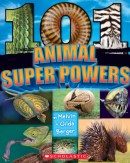
Who needs superhuman heroes when there are animals with their own superpowers? This list gives readers an opportunity to explore all of the ways animals use their skills for surviving in the wild and even help us humans out as well!
Animal Zombies! And Other Bloodsucking Beasts, Creepy Creatures, and Real-Life Monsters by Chana Stiefel
Some may call these creatures creepy, but others will marvel at their special skills.
Insect Superpowers: 18 Real Bugs that Smash, Zap, Hypnotize, Sting, and Devour! by Kate Messner, illustrated by Jillian Nickell
Messner explores the super talents of bugs in this fun title.
Stronger Than Steel: Spider Silk DNA and the Quest for Better Bulletproof Vests, Sutures, and Parachute Rope by Bridget Heos, photographs by Andy Comins
Can you believe that delicate little spiders can create something with such amazing strength that might someday be used to repair or replace human ligaments? Read all-about it in Heos’ Scientists in the Field title.
Superpower Field Guide: Moles and Superpower Field Guide: Eels by Rachel Poliquin, illustrated by Nicholas John Firth
Discover the extraordinary skills of moles and eels in these two guides. Then explore the rest of the series. Poliquin and Firth have two other titles about beavers and ostriches.
Superpower Dogs: Disaster Response Dogs by Cosmic
Dogs have some of the best noses in the business. Learn how they help in disasters.
Super Sniffers: Dog Detectives on the Job by Dorothy Hinshaw Patent
Explore how dogs use their super sniffing detection skills to help humans.
101 Animal Super Powers by Melvin Berger and Gilda Berger
Discover lots of extraordinary animals with this collection of animal superpower stories.

Nancy Castaldo has written books about our planet for over 20 years including, SNIFFER DOGS: How Dogs (and Their Noses) Save The World, so she knows first hand about animal superpowers. Her books have earned the Green Earth Book Award, Junior Library Guild Selection, and other honors. Nancy’s research has taken her all over the world from the Galapagos to Russia. She strives to inform, inspire, and empower her readers. Nancy also served as Regional Advisor Emeritus of the Eastern NY SCBWI region. Her 2020 international title about farm and food is THE FARM THAT FEEDS US: A Year In The Life Of An Organic Farm. Visit her at her website, on Twitter, on Facebook, and on Instagram.

Sibert Honor author Patricia Newman shows young readers how their actions can ripple around the world. Using social and environmental injustice as inspiration, she empowers young readers to seek connections to the real world and to use their imaginations to act on behalf of their communities. One Texas librarian wrote, “Patricia is one of THE BEST nonfiction authors writing for our students in today’s market, and one of our MUST HAVE AUTHORS for every collection.” Titles include: Planet Ocean (new); Sibert Honor book Sea Otter Heroes; Green Earth Book Award winner Plastic, Ahoy!; The NSTA Outstanding Science Trade Book Eavesdropping on Elephants; California Reading Association’s Eureka! Gold winner Zoo Scientists to the Rescue. Visit Patricia online at her website, on Twitter, on Facebook, and on Pinterest.












 marine (l.) and land (r.) iguanas
marine (l.) and land (r.) iguanas 

 Your host is
Your host is 



 Janet Slingerland has written more than 20 nonfiction books for children. She even got to write about sea turtles in 12 Epic Animal Adventures. When she’s not writing, Janet can often be found exploring the world in her own backyard (which sometimes includes turtles!). For more information about Janet, check out her website at
Janet Slingerland has written more than 20 nonfiction books for children. She even got to write about sea turtles in 12 Epic Animal Adventures. When she’s not writing, Janet can often be found exploring the world in her own backyard (which sometimes includes turtles!). For more information about Janet, check out her website at